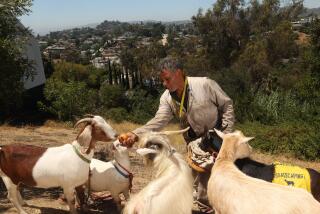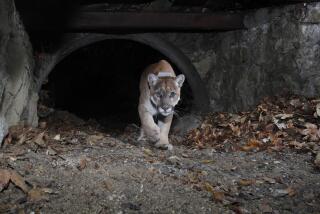Goats Thriving on Olympic Peninsula but That Could Spell Their Demise
PORT ANGELES, Wash. — On Jan. 1, 1925, when game officials released a dozen mountain goats in the crags of the Olympic Peninsula, the nimble animals were meant to be a hunting challenge for sportsmen.
But 62 years later, there are 1,200 goats, and experts say they are destroying the natural balance of Olympic National Park and must be removed.
The white, bearded goat is native to British Columbia and Alaska, as well as to the Cascade Mountains across Puget Sound, where logging work has forced them to higher elevations and reduced their numbers.
Exotic Species
On the peninsula, which has salt water on three sides and lowland river valleys to the south, the goat is an exotic species, but it is thriving.
And that could be its downfall in the 980,000-acre park, where officials are considering trapping, shooting and sterilizing to protect other living things.
Some plant species affected by the goats are survivors of the last Ice Age, said Ed Schreiner, park botanist and plant ecologist. One, the Olympic mountain milk-vetch, is being trampled. “Only 4,000 or 5,000 of these plants exist anywhere,” he said.
He said he does not see evidence of large-scale plant extinction, but said it will take from five to 300 years for plants to recover from the goats’ presence.
The goats’ food preference, for a grass called Idaho fescue, means that other plants have filled in the gap, rocking the delicate balance that evolved long before the goats arrived, said Don Jackson, assistant park superintendent.
The goats also have removed as much as 45 tons of soil in meadows when wallowing to cool themselves, Schreiner said. And Klahhane Ridge, a popular hiking area heavily colonized by the goats, “looks like a barnyard in some places,” he said.
Environmental Study Due
After five years of research, park officials are preparing an environmental assessment, due out within a couple of months. Jackson said it will present several options, costing $55 to $1,200 per goat, without preference. A public comment period will follow.
The cheapest option, certain to create the most heated debate, is to have the goats shot by rangers or contractors. That would cost $55 per animal if the shooting was done from helicopters, $110 from the ground, Jackson said.
“On the ground you get only one try. Once the noise occurs, if you’ve got an animal or not, the rest are gone,” he said.
Robert Chandler, park superintendent, said shooting presents problems:
“It’s a tough position to be in as a park manager when our job is generally protecting wildlife and protecting things that are natural and here we have something that looks like it should be there. It would be natural if we were 80 miles to the east. There are some difficult choices.”
Cleveland Amory, the New York writer who heads the Fund for Animals Inc., said that “the idea of assassinating those goats is going to make a lot of people upset.”
In 1985 and 1986, Amory’s group captured 3,500 threatened wild goats on San Clemente Island in California. The goats were snared in a net, loaded onto a barge and taken to a sanctuary, where they were put up for adoption.
Damaging Bird Habitat
Those goats were either eating or trampling four endangered plants and damaging the habitat of two bird species and a lizard, the Navy said. But the Navy decided in July that trapping was no longer economical, and spent $32,500 to hire civilian sharpshooters, who shot 461 goats.
The Olympic goats do not have to die, say Rolf Johnson, of the state Department of Game’s big game management program, and Charlie Raines, of the Sierra Club’s national park committee.
Goats have been successfully transplanted to other states and to the Cascades, where they are native, they said.
Alaska has the most mountain goats in the United States, a stable population of about 15,000, said Bill Taylor, of the Alaska Department of Fish and Game.
In 1981, park officials began experimenting with methods of cutting the goat herd, including transplanting and sterilization.
Bruce Moorhead, the park’s wildlife management biologist, said nearly 200 goats were moved to Montana, Utah, Nevada and parts of the Cascades.
With transportation and medication, trapping costs about $1,000 per animal. Removing goats by helicopter can cost as much as $1,200 apiece.
“I guess the final question is going to be that if the goats are of such value that they need to be saved and moved somewhere else, can we afford to do it?” asked Chandler.
Favors Sterilization
Amory favors sterilization, partly for its research potential. About 15 of the park’s goats have undergone tubal ligations, vasectomies, or hormonal implants, but the process is nearly as expensive as relocating. And hormonal implants must be repeated periodically.
A combination of alternatives could be used, some officials say.
The rugged terrain makes it difficult to capture all the goats alive, and those that cannot be removed or sterilized safely could be shot, Moorhead said.
Even Amory said that he would not object to controlled shooting if officials tried to sterilize or move most of the goats.
And, although mass shooting is not something the Wilderness Society would welcome, “If all the best research . . . says (trapping the goats) doesn’t seem to work in that rugged country, then it’s necessary to do what is required,” said Jean Durning, that group’s regional director.
“The society’s basic philosophy is that in places that are wild, the natural system is what should be protected. The goats are not part of the natural system there.”
More to Read
Sign up for Essential California
The most important California stories and recommendations in your inbox every morning.
You may occasionally receive promotional content from the Los Angeles Times.










